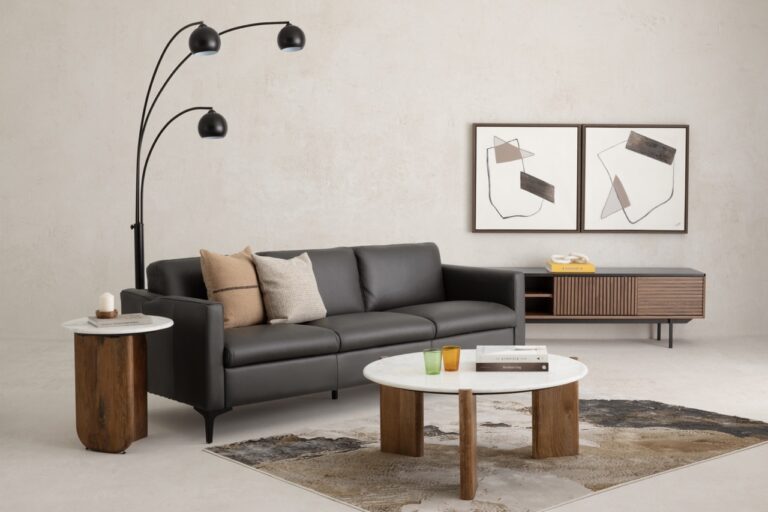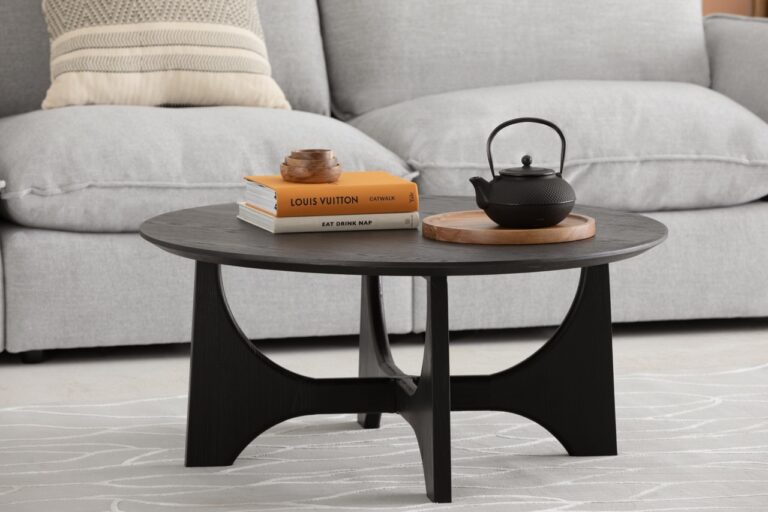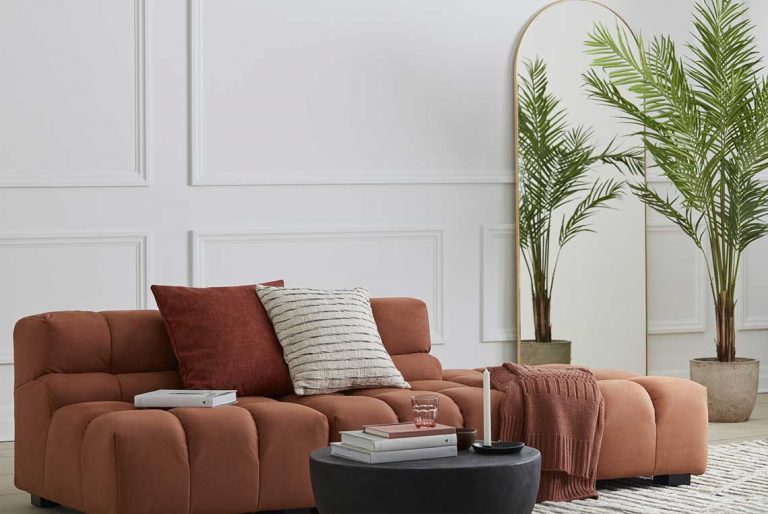In architecture, natural stone’s timeless beauty and unique character have been celebrated for millennia. Natural stone furniture – a trend that’s growing in popularity – brings this same aesthetic into your everyday décor.
Why does this noble material appeal so much to artists? What makes travertine furniture so alluring? Why is marble shrouded in an aura of luxury? Here are some insights from our designers.
The appeal of natural stone
Unique
Each stone carries a distinctive story, shaped by subtle variations in colour, texture, veining, and finish. This is why every piece of natural stone furniture is also a unique artistic creation, with its own nuances and characteristics. Consider it a masterpiece that enhances your home like no other.

Durable
The Colosseum in Rome remains majestic nearly 2000 years after its construction. This demonstrates the extraordinary longevity of natural stone. With minimal maintenance, a piece of furniture made from this exceptional material will retain its beauty and splendour for generations.
Timeless
Natural stone furniture often features subdued, understated colours. This timeless beauty adds luxury and elegance to any environment and effortlessly spans eras. The same marble coffee table could just as easily brighten a minimalist living room as it could complement a Mid-Century Modern decor.
Travertine furniture
Travertine has been used for thousands of years due to its long-lasting durability, sophisticated appearance, and versatile colours.
What is travertine?
Typical of the Mediterranean region, travertine is a limestone rock formed by the accumulation of sediments near mineral-rich hot springs. Water erosion of the stone creates the porous texture that is its signature. Until the 1980s, Italy held a near-monopoly on travertine quarries; now, they exist worldwide, notably in the Middle East and Mexico.

Characteristics of travertine furniture
The earthy colour of classic travertine – a slightly brownish or reddish cream – results from a complex oxidation process. Its texture is porous, covered with endless details and delicate imperfections that enhance its distinctive character.
The Natina collection showcases how this prized material still deserves a prominent place in modern decor. Whether you choose a travertine dining table, side table, or coffee table, each piece features a thick top supported by a sturdy column with antique charm.
Decorating tips for travertine
Travertine is so versatile that it’s hard to go wrong. If you opt for a large piece of furniture, it can easily become the focal point of your room. Its subtle colour integrates well into any decor or provides a backdrop to highlight colourful accessories. Place a decorative vase filled with fresh flowers, a few candles, and an art book on its surface to effortlessly create a chic arrangement.
Marble furniture
Synonymous with luxury and elegance, marble has been cherished by artisans since the dawn of civilization.
Where does marble come from?
The genesis of marble is a complex process that occurs over millions of years. Each piece is a work of art created with care and patience by Mother Nature. Under the influence of heat and intense pressure, the original limestone crystallizes and metamorphoses into a new material. This transformation sometimes leads to the absorption of neighbouring minerals or impurities, enriching its palette of colours and distinctive veining. The precious stone then rises from the Earth’s depths to the surface, where it can be extracted and sculpted.
Our marble furniture
Characteristics of marble
The splendour of marble lies in its rich diversity of colours and patterns, a legacy of its geological past. Its surface can be polished to a mirror-like finish that reflects light. It has been the material of choice for ancient Greek sculptors and Roman architects, but it was during the Renaissance in Italy that it gained prominence in furniture making.
Marble shines brightly when used alone, as demonstrated by the Wamika duo of marble coffee tables. Their minimalist, rounded lines, purity, and rich veining promise to capture all eyes in a modern living room.
But marble also enhances other materials such as wood, glass, and metal. On the Najma coffee table, the white Banswara marble top beautifully complements the rustic and warm character of the rounded mango wood legs. The Westlyn console table combines glass, Carrara marble, and stainless steel to form a contemporary masterpiece with an airy design.
Decorating tips for pairing marble
Although marble comes in all colours, it’s wise to favour timeless shades like white, grey, black, and cream. With proper care, the extreme longevity of marble could allow you to keep your piece for many generations.

Pay close attention to the veining in the marble: do you prefer bold and captivating patterns or fine and subtle lines? Generally, large spaces are conducive to marble with pronounced appearances, while smaller areas benefit from more discreet natural stone looks.
Since its ancient roots, natural stone has become a staple of contemporary decor. It’s a material that skillfully combines form and function, offering the perfect balance of durability, versatility, and beauty. Is design entering a new stone age? We like to think it never really left.

















